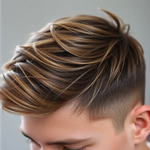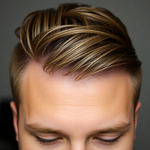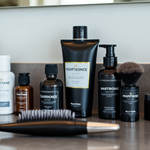
Semi‑Permanent Hair Color for Men: Day‑to‑Night Shade Strategy to Multiply Outfits from a 10‑Piece Sustainable Capsule Wardrobe
10 October 2025
Share
Semi‑Permanent Hair Color for Men: Day‑to‑Night Shade Strategy to Multiply Outfits from a 10‑Piece Sustainable Capsule Wardrobe
Struggling to look fresh with a tiny closet and zero fuss? Here’s how to elevate your style with one smart grooming move and a 10‑piece sustainable capsule wardrobe. Semi‑permanent hair color for men: day‑to‑night shade strategy to multiply outfits from a 10‑piece sustainable capsule wardrobe gives you subtle control over vibe, contrast and perceived variety—without constant shopping or heavy damage.
Semi‑Permanent Hair Color for Men: What it does and why it works for a capsule wardrobe
Semi‑permanent hair color deposits pigment without using peroxide or permanent chemical bonds. It fades gradually over 4–12 washes and often contains conditioning agents, so it refreshes tone while preserving hair integrity. For a capsule wardrobe built on sustainability and versatility, that means:
- Low commitment: try new looks seasonally without long‑term commitment.
- Less damage: healthier hair means fewer product replacements and barbershop fixes.
- Style multiplier: small changes in tone shift how clothing colors read on you, effectively increasing outfit options.
Meet the 10‑piece sustainable capsule wardrobe
Before we deep dive into color, lock the closet. Pick durable, neutral pieces that layer easily and work across functions. The list below covers casual, smart casual and date/meeting looks.
- Charcoal crew tee
- White Oxford shirt
- Navy merino crew or lightweight knit
- Dark slim jeans
- Olive chinos
- Unstructured blazer (navy or grey)
- Lightweight bomber or Menll.com jacket
- Brown leather boots
- Minimal white sustainable trainers (EcoSneak style)
- All‑weather shell or overcoat
Small closet, huge combos: swap shoes, switch the outer layer and tweak hair tone and youʼre suddenly wearing dozens of distinct looks.
How to use semi‑permanent hair color day to night
Think of hair as an accessory that can be tuned to match the time of day and the outfit youʼre wearing. Use three strategic states:
- Day — Natural Bright: +1 level from base, slightly warm for approachable daytime energy. Works with tees, trainers and casual meetings.
- Evening — Depth & Edge: −1 to −2 levels or lowlights to create stronger contrast under artificial light; ideal for dates and evening events.
- Accent — Texture & Detail: targeted tints on fringe, tips or temples to add youthful texture or visual interest without full head commitment.
Example: a man with medium brown hair can use a honey deposit for daytime warmth and a chestnut lowlight for evening sharpness. The wardrobe reads differently under each state—warm daytime tones soften navy and olive, while deeper tones amp up the blazer and boots combo.
Choosing the right shade for skin tone, eye color and wardrobe
Picking a shade isnʼt purely aesthetic—balance hair tone with skin undertone and clothes to avoid clashes. Short guide:
- Warm skin undertones: favor warm deposits (golden, honey, copper). These pair well with camel, olive and brown footwear.
- Cool skin undertones: choose ash, graphite or cool chestnut. Complement navy, grey and black clothing.
- Neutral undertones: youʼre flexible—use hair color to push wardrobe tones either warm or cool depending on the look you want.
- Eye color cues: blue/green eyes pop with cool ash or graphite; brown eyes often look richer with warm chestnut or subtle copper accents.
Keep changes modest: aim for shades within 1–2 levels of your natural tone to avoid a look that reads artificial under workplace lighting.
Step‑by‑step at‑home application (safe and repeatable)
If you opt for at‑home color, follow a disciplined routine:
- Do a 48‑hour patch test to check for allergies.
- Choose an ammonia‑free semi‑permanent product or color‑depositing conditioner. Look for brands with clean ingredients and recyclable packaging.
- Start with dry or towel‑damp hair as instructed by the product. For even coverage, use a comb and gloves.
- Apply to the mid‑lengths and ends first if youʼre doing an accent; apply to roots last to avoid overly dark roots.
- Follow development time exactly. Rinse with cool water to seal the cuticle and prolong wash resistance.
- Use a sulfate‑free shampoo and a color‑depositing conditioner weekly to refresh tone without repeated full applications.
Safety note: if you have scalp irritation, active dermatitis or are unsure about interactions with topical medications, consult a dermatologist. For general hair color safety and risks, see this WebMD overview: webmd.com/hair-color.
Maintenance schedule and low‑waste routines
A simple maintenance calendar keeps color vibrant and minimizes product waste:
- Week 1: full application. Use mild sulfate‑free shampoo twice during week 1 and condition.
- Week 2–4: use color‑depositing conditioner once a week; reduce shampooing frequency where possible.
- Monthly: reassess shade intensity. If fading too fast, switch to a longer‑wear demi product or increase conditioning treatments.
- Seasonal swaps: perform a full refresh at season change to match wardrobe shifts (spring: warmer; fall/winter: deeper tones).
Choose refillable or concentrated products and buy from brands with take‑back or recycling programs to align with sustainable habits.
Styling routines that protect color and save time
Fast, repeatable routines matter when you want consistent results without daily effort. Try these three micro‑routines:
- 5‑Minute Morning (casual): apply lightweight leave‑in conditioner with UV protection, run fingers through for texture, and spritz a salt spray for matte finish.
- 10‑Minute Pre‑Night (smart casual): blow dry roots for lift with a heat protectant, apply a small amount of matte paste to shape, and finish with a quick mist of invisible hairspray.
- Weekly Color Refresh: apply a color‑depositing mask in the shower for 5–10 minutes, rinse and follow with a deep conditioner to lock moisture.
Outfit matrix: how each hair state multiplies looks from the 10 pieces
Below are 12 concrete outfit permutations tied to hair state. Swap shoes or outerwear to expand further.
-
Day Hair — Natural Bright:
- Charcoal tee + dark jeans + white trainers (errands, coffee runs)
- White Oxford + chinos + sneakers (casual office)
- Navy knit + jeans + brown boots (brunch)
-
Night Hair — Depth & Edge:
- Navy knit + blazer + boots (date night)
- White Oxford + dark jeans + bomber (smart casual drinks)
- Charcoal tee + leather boots + overcoat (concert or gallery)
-
Accent Hair — Texture & Detail:
- Charcoal tee + bomber + trainers with subtle copper tips (weekend)
- White Oxford + blazer + boots with graphite fringe (evening)
- Navy knit + chinos + overcoat with cool ash temple accents (office-to-night)
Each comboʼs personality changes with hair tone. Thatʼs the multiplier effect: same garments, different vibes.
Seasonal adjustments and event tactics
Plan color with calendars and events in mind:
- Summer: lighter, sun‑kissed deposits and color‑protective leave‑ins to combat UV fading.
- Fall/Winter: deeper tones to match heavier fabrics and low natural light; use richer conditioning masks to fight dryness.
- Vacations: choose more durable color deposits or plan reapplications around travel days to avoid midtrip fading.
Salon vs at‑home: when to seek the pros
Choose a salon when you want complex color work (highlights, lifts or color corrections). For subtle shifts, at‑home semi‑permanent products are cost‑effective and safe. If in doubt, book a consultation—many salons now offer eco‑friendly product lines to align with sustainable wardrobes.
Troubleshooting and FAQs
- Q: My color looks muddy after one wash. Why? A: Likely over‑application or leaving the product on too long. Rinse thoroughly and use a clarifying shampoo once, then a deep conditioner.
- Q: Can I layer two semi‑permanent shades? A: Yes, but test on a small section first. Layering works best when shades are complementary and the hair is healthy.
- Q: How long until I can change shades? A: You can change within 4–12 washes depending on product fade; use color‑stripping shampoos if you need a faster reset (use cautiously).
Cost, timing and real‑world expectations
Budgeting helps plan a sustainable approach:
- At‑home semi‑permanent kit: $15–$40 and lasts multiple applications depending on coverage.
- Salon semi‑permanent: $50–$120 for professional color and shaping.
- Time: at‑home sessions take 20–45 minutes total; salon visits range 45–90 minutes.
Realistic expectation: youʼll get subtle, style‑shifting results that multiply outfit impact without the time and resource drain of frequent shopping.
Ingredients to favor and avoid
Favor: conditioning agents, botanical extracts, ammonia‑free formulas and products with clear refill or recycling programs. Avoid: products with high peroxide levels, strong fragrances that may irritate sensitive scalps, or poorly reviewed chemicals that compromise hair health.
How this strategy serves different audience segments
Whether youʼre a young professional, fitness guy, or budget‑minded student, semi‑permanent color can work for you:
- Young professionals: subtle depth for meetings and networking without the commitment of permanent color.
- Fitness and outdoors enthusiasts: low‑maintenance color that wonʼt require weekly salon trips and pairs well with functional outerwear.
- Budget‑conscious shoppers: one low‑cost product and ten wardrobe pieces reduce overall spending while delivering variety.
Sustainability checklist
To keep this approach eco‑minded, follow these practices:
- Buy concentrated or refillable color products when available.
- Choose sulfate‑free and biodegradable formulas.
- Recycle packaging and choose brands with take‑back programs.
- Extend garment life: repair, re‑hem or re‑sole shoes rather than replace.
Before you start: quick health and styling prep
- Trim splits and get a tidy cut—healthy hair takes color better and looks sharper in camera and low light.
- Hydrate hair with a deep conditioner 48 hours before coloring for even deposit.
- Map your first two weeks of outfits to test how color behaves with daily activities and light conditions.
Meta title and description (SEO ready)
Meta title (55 chars): Semi‑Permanent Hair Color for Men — Day‑to‑Night Strategy
Meta description (158 chars): Semi‑permanent hair color for men: day‑to‑night shade strategy to multiply outfits from a 10‑piece sustainable capsule wardrobe. Practical steps, care, and styling.
Suggested clean URL: menll.com/blog/semi-permanent-hair-color-men-day-night-strategy
One‑sentence product note
For sustainable layers that complement hair‑driven style changes, check Menll.comʼs outerwear collection and sustainable basics to make each shade read its best—Menll.com builds pieces to last and mix well with low‑maintenance grooming.
Final checklist and next steps
- Decide which of the three hair states you want to test first (day, night or accent).
- Buy a small at‑home semi‑permanent kit and a color‑depositing conditioner for maintenance.
- Plan one weekend session to try the shade, then map three outfits per state out of your 10 pieces to measure the multiplier effect.
Which shade are you trying first—natural bright, depth & edge, or an accent? Tell us in the comments and tag a mate who needs a style upgrade. For sustainable wardrobe picks and easy layering options, browse Menll.com today.
Prev post
Next post

Case Study: Turning a 12‑Piece Men's Capsule Wardrobe into 30 Outfits Using Semi‑Permanent Hair Color
Updated on 08 October 2025






